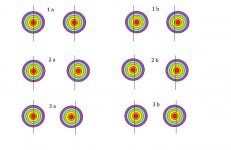looksharp65
Well-known member

This has been on my ToDo list for a while and this is the draft that my thoughts have resulted in.
At times we encounter binoculars that behave like IPD setting is critical. The reasons may vary, but I would like to point out how the effect of inaccurate IPD setting affects a binocular with curvature of field.
The coloured "dartboards" show the wavefront of the beam pencil through the binocular, and simply show that the focus increasingly differs with the transverse distance from the center of the beam.
The thin black vertical lines mark the user's IPD.
Fig. 1 a shows the ideal situation with IPD correctly set and the binoculars centered in front of the eyes.
Fig. 1 b shows a horisontal displacement of the instrument but with correct IPD setting maintained. The eyes look through corresponding dioptrical parts of the beams.
Fig. 2 a shows an IPD setting that is too wide and one eye is centered.
The eyes look through dioptrically non-corresponding parts of the beams.
If the diopter is changed rather than the IPD setting, a temporary improvement may seem to occur but it will soon be obvious that the real problem is not adressed.
Fig. 2 b shows an IPD setting that is still too wide but the horisontal position change allows for dioptrical equilibrium - as long as the observer strictly looks straight forward.
Fig. 3 a is basically the same as 2 a but the IPD setting is too narrow and only one eye is centered behind the ocular.
Finally, fig. 3 b is the same IPD setting but with the horisontal position adjusted to find dioptrical equilibrium.
........|:S|
Considering the importance of a correct diopter setting and a correct IPD setting, adding the occasional need to adjust the IPD for nearer distances, which in turn is a slightly constrained way to handle convergence and parallax issues compared to using actual optical axis convergence by mechanical means, then the common need for different diopter settings for different distances, everything suggests that reasonably flat fields should be preferred.
//L
At times we encounter binoculars that behave like IPD setting is critical. The reasons may vary, but I would like to point out how the effect of inaccurate IPD setting affects a binocular with curvature of field.
The coloured "dartboards" show the wavefront of the beam pencil through the binocular, and simply show that the focus increasingly differs with the transverse distance from the center of the beam.
The thin black vertical lines mark the user's IPD.
Fig. 1 a shows the ideal situation with IPD correctly set and the binoculars centered in front of the eyes.
Fig. 1 b shows a horisontal displacement of the instrument but with correct IPD setting maintained. The eyes look through corresponding dioptrical parts of the beams.
Fig. 2 a shows an IPD setting that is too wide and one eye is centered.
The eyes look through dioptrically non-corresponding parts of the beams.
If the diopter is changed rather than the IPD setting, a temporary improvement may seem to occur but it will soon be obvious that the real problem is not adressed.
Fig. 2 b shows an IPD setting that is still too wide but the horisontal position change allows for dioptrical equilibrium - as long as the observer strictly looks straight forward.
Fig. 3 a is basically the same as 2 a but the IPD setting is too narrow and only one eye is centered behind the ocular.
Finally, fig. 3 b is the same IPD setting but with the horisontal position adjusted to find dioptrical equilibrium.
........|:S|
Considering the importance of a correct diopter setting and a correct IPD setting, adding the occasional need to adjust the IPD for nearer distances, which in turn is a slightly constrained way to handle convergence and parallax issues compared to using actual optical axis convergence by mechanical means, then the common need for different diopter settings for different distances, everything suggests that reasonably flat fields should be preferred.
//L
Attachments
Last edited:





